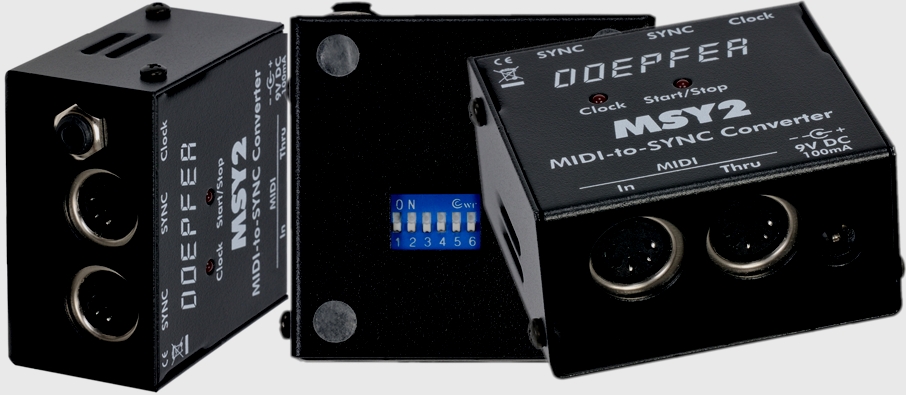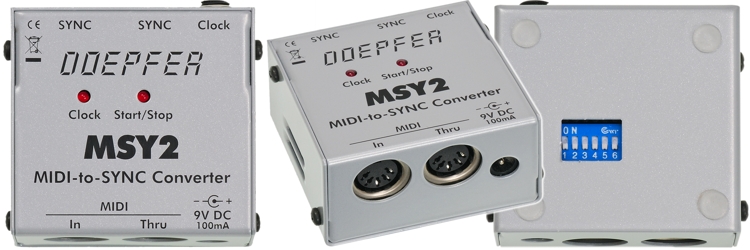|
MSY2 |
|
|
MIDI-to-SYNC/Clock Interface |
|

|
|
|
schwarze Version
(produziert ab Frühjahr 2011) / black version (manufactured
from spring 2011) Klicken Sie auf das Bild um ein Foto mit höherer Auflösung zu erhalten / Click to the picture to obtain a higher resolution picture |
|

|
|
|
silbergraue
Version (produziert bis Frühjahr 2011) / silver-grey
version (manufactured until spring 2011) Klicken Sie auf das Bild um ein Foto mit höherer Auflösung zu erhalten / Click to the picture to obtain a higher resolution picture |
|
|
|
|
|
MSY2 setzt die MIDI-Befehle Start, Stop und Clock auf die entsprechenden Signale Clock und Start/Stop SYNC-Norm um, die beispielsweise bei den Geräten TB303 (Bass-Line) oder TR808 (Drum-Computer) der Firma Roland verwendet wurde. Details zur DIN SYNC-Norm finden Sie auf unserer FAQ-Seite: SYNC specification |
MSY2 is an interface that converts the MIDI realtime events Clock, Start and Stop into the corresponding signals Clock and Start/Stop of the SYNC standard. This standard was used e.g. in the Roland devices TB303 bass line or TR808 rhythm composer. Details about the DIN SYNC standard are available at our FAQ page: SYNC specification |
| MSY2 verfügt über 2 parallel geschaltete SYNC-Buchsen und eine Clock-Buchse (monophone 3.5mm Klinkenbuchse). An den SYNC-Buchsen stehen das Clock-Signal (0/5V-Impulse) und das Start/Stop-Signal (Start = +5V, Stop = 0V) zur Verfügung. Das Clock-Signal ist zusätzlich an eine eigene Clock-Buchse geführt, um z.B. den Arpeggio-Steuereingang eines Synthesizers MIDI-synchron anzusteuern. | MSY2 is equipped with 2 SYNC DIN sockets (switched in parallel), a Clock miniature jack socket (3.5mm monophonic), MIDI-in and MIDI-Thru. SYNC-CLOCK is a periodic signal (0/+5V) representing the tempo. SYNC-START/STOP is a signal that indicates one of the 2 possible states: START = +5V, STOP = 0V. The Clock pin of the SYNC standard is additionally available from a miniature jack socket e.g. for synchronizing the arpeggio input of an analog synthesizer with MIDI. |
|
Der SYNC/MIDI-Clock-Teilerfaktor ist über von
außen zugängliche DIP-Schalter zwischen 1:1 und 1:16 einstellbar. Das
entspricht 96...6 ppm oder 24...1,5 ppq (ppm = pulses per measure /
Impulse pro Takt, ppq = pulses per quarter note / Impulse pro
Viertel-Note). Bei einem Teilerfaktor 1:1 (d.h. jedes Midi-Clock-Event erzeugt einen Clock-Impuls) hat die Impulsbreite des Clock-Ausgangs einen festen Wert von ca. 4 Millisekunden. Bei Teilerfaktoren größer als 1 entspricht die Pulsbreite dem gewählten Teilerfaktor. Außerdem sind die Polaritäten von Start/Stop und Clock über 2 weitere DIP-Schalter wählbar. Der Teilerfaktor gibt an, nach wie vielen MIDI-Clock-Befehlen ein neuer SYNC-Clock ausgelöst wird. Bei Teilerfaktoren größer als 1 entspricht die Pulsbreite |
MSY2 enables the 1:1 conversion of MIDI CLOCK
into SYNC CLOCK (i.e. 1 MIDI clock triggers 1 SYNC clock pulse), as well as
the reduction of the tempo by dividing the incoming MIDI clock frequency
by an integer factor. The factor can be set to any value between 1 and 16
with a DIP switch at the bottom of the MSY2. This corresponds to 96...6
ppm or 24...1,5 ppq (ppm = pulses per measure / ppq = pulses per quarter
note). Factor 1 corresponds to the 1:1 conversion. In this case the pulse width of the clock output is fixed to about 4 milliseconds. 16 is the maximum of frequency reduction, i.e. after 16 MIDI clocks 1 SYNC clock appears. For all dividing factors beyond 1 the pulsewidth of the clock signal corresponds to the selected dividing factor. |
| Die Polaritäts-Schalter legen fest ob ein +5V- oder ein 0V-Pegel den aktiven Zustand von Start/Stop bzw. Clock angeben. Damit sind neben der Standard-Anwendung des MSY2 (Ansteuerung von Geräten mit der Roland-kompatiblen SYNC-Buchse) auch andere ausgefallene Steuerungen möglich. | With two other switches the Start/Stop polarity and the Clock polarity can be changed for special applications not following the SYNC standard. |
| SYNC-Clock und SYNC-Start/Stop werden über 2 Leuchtdioden optisch angezeigt. | Clock and Start/Stop are displayed with 2 LEDs. |
| MIDI-In, MIDI-Thru | MIDI In, MIDI Thru |
| Stromversorgung über externes
Steckernetzteil 230V mit Eurostecker bei Lieferungen innerhalb Europas ist ein Steckernetzteil für 230V mit Eurostecker enthalten Netzteile für andere Netzstecker oder Netzspannungen müssen vom Benutzer im jeweiligen Land erworben werden, 7...15V/100mA DC erforderlich, Kleinspannungsstecker mit 5,5 mm Außen-Durchmesser und 2,1 oder 2,5 mm Innen-Durchmesser, Polung: plus innen/minus außen |
external AC adapter for power supply AC adapter for 230V AC and European type of mains connector is included within Europe adapters for other voltages or other mains connector types has to be purchased by the customer in his country, 7...15V/100mA DC required, DC connector with 5.5 mm outer diameter and 2.1 or 2.5 mm inner diameter, polarity: plus = center, minus = ring, please ask the representative in your country if you cannot find a suitable supply |
|
Für Geräte ausgeliefert bis Sommer 2014: Falls der verwendete MIDI-Sender 100% der MIDI-Norm entspricht, kann die Stromversorgung auch direkt aus der MIDI-Leitung erfolgen (d.h. kein eigenes Netzteil erforderlich). In diesem Fall muß im Gerät ein Jumper (Steckbrücke) umgesetzt werden. Diese Art der Stromversorgung ist jedoch nicht in Verbindung mit allen MIDI-Geräten möglich und muß von Fall zu Fall ausprobiert werden! Ab Werk wird daher der interne Jumper für die Netzteil-Version vorgesehen. Bei allen ab Sommer 2014 ausgelieferten Geräten ist die Stromversorgung über Midi nicht mehr möglich ! |
Only for units manufactured before summe 2014: For the power supply of the MSY2 there are possible solutions: external power supply or supply via MIDI In. The external power supply version will work in any case (7...15V DC / min. 100mA required). The power supply via MIDI will work only if the MIDI controlling device is in full agreement with the MIDI hardware standard. Inside the MSY2 case is a jumper to select the type of power supply. The factory setting is for external power supply. You have to try out with your MIDI device whether the power supply via MIDI in will work. For all units manufactured since summer 2014 powering via Midi is no longer possible ! |
|
MSY2 ist in einem stabilen Metall-Gehäuse
(ca. 60 x 60x 35 mm) aus 1 mm Stahlblech untergebracht. Bis Frühjahr 2011 war die Gehäusefarbe silbergrau. Ab Frühjahr 2011 ist die Gehäusefarbe auf schwarz. |
MSY2 is built into a stable metal case (about
60 x 60x 35 mm) made from 1 mm sheet steel. Until spring 2011 the case color was silver-grey. From spring 2011 the case color is black. |
|
Die deutschen
MSY2-Bedienungsanleitungen sind als pdf-Dateien verfügbar: Version 1 (bis 2014) Version 2 (ab 2014) Weitere Hinweise zur SYNC-Norm finden Sie auf unseren FAQ-Seiten. |
English
MSY2 user's guides: version 1 (until 2014) version 2 (from 2014) General details concerning the SYNC standard are available on our FAQ page. |
|
Preise: Euro 92,00 incl. Steckernetzteil für 230V mit Eurostecker Euro 87,00 ohne Netzteil Passendes SYNC-Kabel, ca. 1,20 m: Euro 7,00 Wir empfehlen Ihnen das Kabel bei Bedarf gleich mitzubestellen, da eine spätere Nachlieferung wegen des geringen Warenwertes nicht möglich ist, bzw. mit höheren Kosten verbunden ist (Mindermengenzuschlag, nochmalige Versandkosten). |
Prices: Euro 92.00 incl. 230V power supply with European plug type Euro 87.00 without power supply suitable SYNC cable, about 1.20m: Euro 7.00 If desired please order the cable together with the MSY2 as a separate order only for the cable cannot be accepted resp. causes high processing and shipment charges because of the small value for the cable only. The prices in US$ depend upon the exchange rate between Euro and US$ at the payment day. |
Wichtige technische
Hinweise:
|
Important technical notes:
|